Carnations, a florist’s favourite, are sure to make you smile with their aromatic, aesthetically appealing, and long-lasting attributes. This makes them perfect for cut and dried flower arrangements.
What’s interesting is they can be grown from the comfort of one’s home. Follow our growing guide to bring a striking addition to your garden.
More...
What are Carnations?
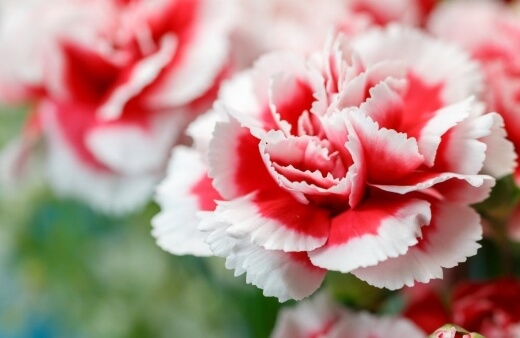
The carnation (Dianthus caryophyllus) is a wonderfully fragrant and delicate flower with a rich and meaningful history. Its scientific name ‘Dianthus’ roughly translates to ‘flower of love’ or ‘flower of god’. Get to know more about Dianthus and its other varieties here.
They are the second most popular, commercially grown flower in the world and this is because they are easy to care for, produce a lot of flowers, and are very beautiful with a strong scent.
They come in several different colours and these diverse colours symbolise different emotions.
For instance, light red carnations are used to express admiration while dark red ones are used for deeper and more passionate feelings like love. Further, white coloured ones symbolise remembrance of pure love.
In wake of these expressions, pink carnations became a popular flower for Mother’s Day in the 20th century as they are symbolic of gratitude and motherly love.
The beauty, aroma, and powerful sentiments conveyed through the flower make them perfect for all types of occasions.
To trace the history of the flower, they are said to have originated from Eurasia about 2000 years ago and they have been used by the Europeans for centuries for decoration as well as for reasons which will be described later in the article.
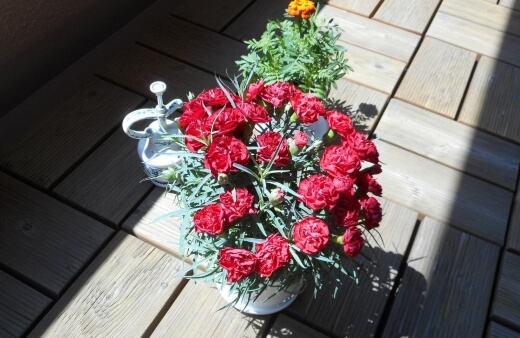
Currently, the world centre for commercial carnation production is in Bogota, Columbia. However, they are also grown in other countries like Spain, Colorado, and Kenya for commercial purposes.
Dianthus grows best in cool temperate climates. The flower tends to struggle in higher temperatures and grows well in mild, cool tropical weather.
Therefore, the best time to plant them is during transition periods like spring or autumn when it is neither too hot nor too cold for the plant.
The plant has two varieties; tall (with a height of 80 cm and width of 40 cm) and small (with a height of 30-40cm and width of 25-35 cm).
They can grow in the ground or in the containers, taking about 4-6 weeks to bloom, requiring watering at least once a week. Since they come in annual, biennial, and perennial types, they are a suitable choice to be grown in one’s garden.


Get Your Free Guide:
Master Growing Australian Natives eBook
A Must Have Complete Guide for Every Australian Garden
Get Your Free Guide:
Master Growing Australian Natives eBook
A Must Have Complete Guide for Every Australian Garden
Planted in either flower beds or pots, dianthus is a versatile plant with both single and double flower varieties with the blooms springing on forked clusters.
The three different types of the flower include large-flowered carnations that have one large bloom and are the florists’ flower, while spray and dwarf carnations have many blooms per stem and are grown in the gardens.
Interestingly, the flower has several medicinal uses, for instance it contains substances that calm the nervous system, act as a toner for fever and the oil extracted from it helps to treat skin rashes and eczema.
The tea made using its petals helps to ease nervousness and the flower has heart benefits as well. Therefore, while the flower is visually appealing, its edible properties also help soothe a person in many ways, making it an important plant to grow.
Planting Carnations
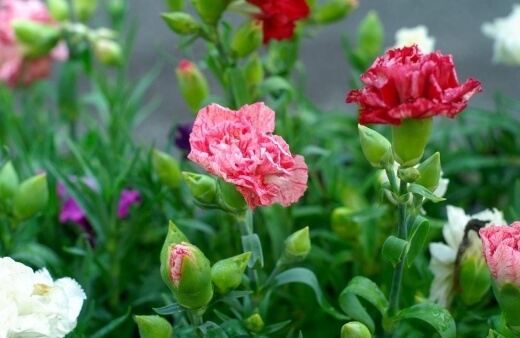
To sow the plant, remove the weeds and add organic matter into the top 6-8 inches of the soil and then sow the seeds ¼ inch deep into the soil. Within 14-21 days, the seedlings start to emerge if other factors are carefully accounted for.
The ideal season to plant the seeds is in late fall to early spring. They grow best in temperatures that range from 10 to 18°C during the day and 4 to 10°C during night time.
While planting them, one must ensure to plant them in an area that gets 4-6 hours of sunlight since the plant prefers sunlight rather than shade.
Since they thrive better in the morning sunlight than afternoon light, therefore while planting these factors should be considered as extreme heat can kill the plant.
It is important to space the plants 10-12 inches apart in order to ensure good air circulation for them. The plant requires well-drained, fertile soil and has a tendency to grow well in alkaline conditions with a pH level of 6.7-6.9.
Soils that are too rich and water-absorbent are detrimental to the growth of the plant since they will lead to the growth of too many leaves and too few flowers.
Moreover, wet soil leads to yellowed and discoloured leaves and can kill plants. In order to have well-drained soil, cow manure or compost should be applied to the soil before planting for good results.
Are you a fan of making your own compost? If you are, then you'd love our review on the best compost bins available in Australia.
Growing Carnations in Australia
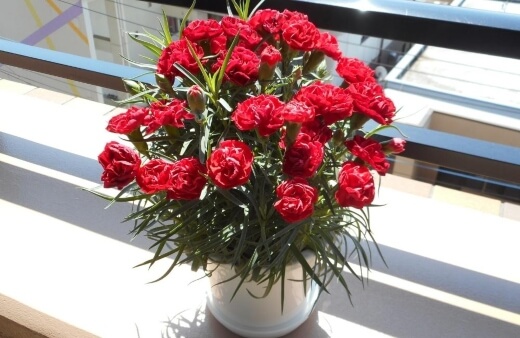
In addition to sowing seeds directly in the garden, another option is to transplant them in the garden. The steps for this include:
- Transplant seedlings to the garden after all danger of frost. Select a location in full sun with loose, well-drained soil.
- Prepare the bed by turning the soil under to a depth of 6-12, removing any debris, and lightly raking as level as possible.
- The addition of organic matter (leaf mould, compost, well-rotted manure) benefits all gardens and is essential in recently constructed neighbourhoods.
- Plant on a cloudy day or in the late afternoon to reduce transplant shock.
- Dig a hole for each plant, approximately 12 inches apart, large enough to easily accommodate the root ball.
- Unpot the plant and gently loosen the root ball with your hands to encourage good root growth.
- Place the top of the root ball even with the level of the surrounding soil. Fill with soil to the top of the root ball. Press the soil down firmly with your hand.
- Thoroughly water and apply a light mulch layer on top of the soil (1-2 inches) to conserve water and reduce weeds.
How to Propagate Carnations
Carnations can be propagated by stem cuttings, seeds, and division.
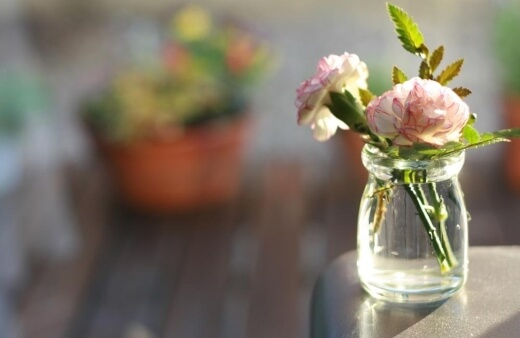
Propagating Carnations from Seeds
The seeds should be planted in well-drained, fertile soil about 1/8th inch depth and 12 inches apart from one another in order to ensure air circulation. The seeds should be watered once a week to keep the soil moist and are expected to germinate within 2-3 weeks.
Propagating Dianthus caryophyllus from Cuttings
In this case, professional farmers grow carnations from stem cuttings by using terminal flowers. The cuttings need to be 4-6 inches long.
The propagation requires them to be inserted into pure sand and they are likely to be ready in 25-30 days for transplantation. This method is suitable for perennial carnations.
Growing from Division
Under this method, an old Dianthus caryophyllus can be revived by dividing the plant to create multiple plants. Dig up the plant segments from the clumps and replant them.
The plants should be watered well and this process should be done every few years in order to keep them healthy.
Carnations Care Guide
How much water carnations need
Once the carnation has been planted, it is important to care for the plant on a regular basis. One of the key considerations is water. The plant should not be watered a lot since that leads to yellowed leaves, root rot, and blossom drop.
It is advised to water the plant regularly, about 1 inch each week from either rainfall or irrigation in order to keep the soil moist. To avoid the problem of over watering, feel the soil. This will help you know if the water from the last watering has dried.
What to feed your carnations
A water-soluble, slow-release, or granular fertiliser with a formula for 5-10-10 should be mixed into the top 4-6 inches of the planting bed.
It is necessary to reapply the fertiliser every six to eight weeks in order to preserve the nutrients of the soil. Also, make sure the fertiliser you chose contains less nitrogen than phosphorus for the plant to thrive.

Mulching
Mulches help to retain the moisture of the soil, therefore an even layer of organic mulch of aged bark or shredded leaves helps to restore the soil temperatures.
Pine needles as mulch are also effective since the clove pink flower blooms well in acidic soil and needles provide acidity to the soil as they decompose.
Pruning
Although the plant requires minimal trimming, they need to be pruned at regular intervals in order to ensure that they receive sufficient air circulation to avoid the risk of diseases.
If you are on the market for a reliable pruning shears, don't miss our review on the best secateurs you can easily get online.
In order to ascertain that new flowers keep blooming, it is essential to deadhead the wilting flowers frequently so that more water and nutrients can be dedicated to the healthy parts of the plant.
Harvesting Carnations
After planting, it takes about 4 months for the plant to reach the peak flowering stage. In commercial carnation production, one can expect a yield of 15 flowers per plant.
Carnation picking should be done 2-3 times a week with long stems. Post harvesting, the flowers should be placed in a plastic bucket with clean water and they should be pre-cooled at 20°C for 3 hours.
Common Carnation Pests and Diseases
These flowers fall prey to the following diseases and to identify and avoid them, you should definitely read the section below:
Fairy Ring Leaf Spot
This disease is produced by Mycosphaerella dianthi fungus. It is visible on the plant as round/oval spots which are yellow or brown in colour and have a red margin start to grow.
The result is that the affected flowers follow an irregular pattern of growth. In order to prevent this disease from occurring, it is important to stop overwatering the plant.
Rust
This disease is caused by Uromyces caryophyllus fungus and it attacks the stems and leaves of the plant. The result is that the affected plants have thin stems, do not bloom and even if they do the flowers are bleached.
In order to prevent this disease from occurring, excess moisture in the crop should be avoided.
Blight
This disease is caused by Alternaria dianthi fungus and it not only attacks the stems and leaves but also the flowers. The affected parts have circular, grey/white spots, covered by a black mould in the centre.
Due to this disease, the stems start breaking off, and therefore the plants affected by it have shorter internodes and bloom less.
In order to prevent it from occurring, excess moisture in the plant’s growing space should be avoided and healthy cuttings should be used.
Just like other flowers, they also catch pests. Let’s get to know how to identify and avoid these pests.
- Aphids. Greenish, red, or black coloured sucking insects feed on the underside of the leaves. As they leave a sticky residue on the foliage, it tends to attract ants and hence causes the spread of diseases. An effective pesticide recommended for this is Calypso 480 SC (2ml/ 10 l water).
- Thrips. These are tiny insects that are straw coloured. They suck the juices from the plants and attack the flowers, stems, and leaves. Thrips tend to spread diseases from plant to plant. An effective pesticide recommended for this is Confidor Energy (25 ml/10 l water).
Final Tips for Growing Carnations
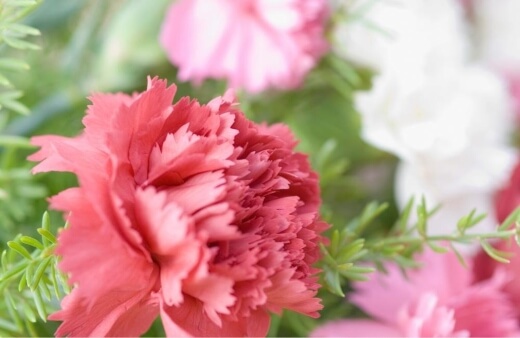
- Water plants two to three times a week. If the petals or foliage begin to turn yellow, it’s a sign of overwatering.
- To promote reblooming, remove any dying blooms or leaves.
- They aren’t usually bothered by pests, so there is no need to apply pesticides.
- Allow enough circulation between plants to prevent mould, fungus, and mildew.
- Tall varieties of the plant may need support that holds up the stem as the plant grows.
- If the soil needs more nutrients, you can use peat; it’s common manure used for carnation growing
Note: Carnation is poisonous for both dogs and cats as symptoms include dehydration and diarrhoea, hence while planting be careful to place them away from your pets!
Do you want to add more colorful plants to your garden? Add English bluebells and Mandevillas to your list.
Carnations Frequently Asked Questions
What does a carnation symbolise?
Carnations have long been used to symbolise love and devotion, and their use in popular culture has cemented their reputation as a universal symbol of budding romance.
It’s easy to understand their relationship to love too, with a pungent floral aroma and as a long-lasting cut flower, they make excellent additions to bouquets and flower arrangements.
Do carnations grow back every year?
Carnations are perennial plants that will come back every year, with more blooms each year, and the plant slowly but surely spreads by root and seed to fill its container. Even in the ground, carnations make excellent ground-cover but need good drainage to see them through wet winters.
How poisonous are carnations?
Carnations are not toxic to humans, but the leaves and stems can cause mild stomach upset. Carnations are mildly toxic to cats and can cause rashes and itching in humans and animals if their sap is in contact with skin.
Are carnations edible?
The flowers of carnations are edible, and make a gorgeous addition to salads. Though their petals have a mild flavour, they can add sweetness if picked early in the morning and look delicious with plucked petals strewn over a cake or dessert.
Are carnations asexual?
Carnations can be propagated asexually through self-pollination, but you will get more seeds with multiple plants as they are capable of both types of reproduction. Carnation seeds aren’t really useful until later in the season though, so deadhead regularly to prolong flowering.
Are pinks carnations?
Pink, dianthus, and carnations are one and the same, with subtle variations in height, leaf form, and colour. They are all part of the Caryophyllaceae family and can reproduce through cross-pollination.
For reliable seedlings each year, manually pollinate varieties together, rather than letting pollinating insects create accidental hybrids.
Are carnation flowers good for you?
Carnation flowers, like most edible flowers, have very few nutrients, but their chemical makeup does make them a potentially useful remedy for inflammation and swelling.
It can be crushed to extract oils, or brewed into a tea.
Do carnations multiply?
Carnations can naturally multiply on moist but well-drained soil in full sun. Their seeds survive winter in the soil in most conditions and will self-propagate in their pots. The plants themselves can also reach a spread of 30+ cm depending on the variety.
Do carnations grow well in pots?
Carnations grow well in pots and in the ground, but in my experience, I’ve had much more success with carnations in pots and window boxes than in the ground. Damp soil conditions can rot carnation roots, so container drainage helps them to establish, and create stronger, bigger, plants faster.
What is the lifespan of a carnation?
Carnations last for years in the ground and will self-seed in the garden, so there should be no need to buy more. After about five years, carnations tend to lose their vigour, so it’s best to take cuttings or divide clumps of carnations to give your flower beds a boost every two years.
What are the three most common types of carnations?
The three most common types of carnations are miniature carnations (about 10-20 cm tall, with several flowers per stem), dwarf carnations (5-10 cm with varying flowering habits, but dense silvery foliage), and standard carnations (with larger flowers and stems up to 60cm tall).
Are carnations low maintenance?
Carnations are incredibly low-maintenance plants, and can cope with really quite tough conditions. We’ve got some gorgeous dwarf carnations planted around the base of a cherry tree.
In theory, that shouldn’t work, but they’ve spread well, and now create a dense mat of pink blooms each year under the partial shade and poor soil beneath the tree.
Carnations Add Beauty to Any Garden
Carnation is a must-have flower, perfect for all occasions that adds to the beauty of your garden, is easy to cultivate, and has a long vase life. This plant is exotic to Australia with Victoria being the largest carnation-producing state.
Once you are equipped with the information regarding the plant, growing carnations in Australia becomes pretty easy!

Published on January 18, 2023 by Maisie Blevins
Last Updated on September 9, 2024





You mention that carnations sometimes need support. I have seen a wire rod frame on a gardening program, but have not been able to find a reference or a source. Do you know of any sources?
Hi,
It’s for the taller varieties, especially in windy gardens. Their stems are tough, but can still snap or bend in the wind so it’s worth providing a little bit of support primitively.
These basic wire frames are great because they take up very little space in the shed over winter, and can be installed before plants even begin to send up shoots. Then by the time they’re started flowering, the bulk of your carnations will cover them so all you see is foliage and gorgeous flowers.
If you’re running late and your carnations are already flowering, then these support stakes are a decent alternative. Simply twist them around individual stems, and if you need to provide support for the plant in general, tie twine between wire supports to create a catch-all ring around each clump.
And for a completely free alternative, you can achieve similar results by plunging three bamboo canes into the ground on the outside of the plant, then running a ring or twine or wire. It’s the same results as the half-round frames above, and allows plants to move slightly in the wind without too much restriction.
Best regards,
Maisie Blevins